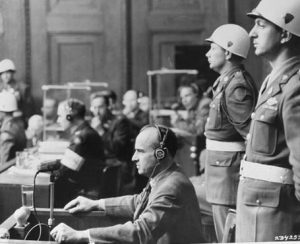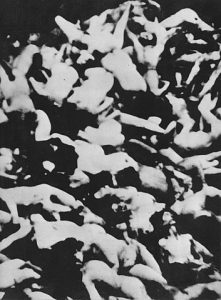Frank, My Dear, We Don’t Give a Damn

The Nuremberg boys (Hans Frank in the dock's front row, with arms folded, wearing dark glasses)
East West Street, written by Philippe Sands (2017)
“To do a great right, do a little wrong” (The Merchant of Venice, Act IV, Scene 1)
It was a dilemma – in the smoking ashes of WWII, there were several handfuls of Nazi insiders scooped-up by the Allied forces. What to do with them? Hitler and his main henchmen were gone, bullets in their brains or cyanide caps twixt their clenched teeth (sometimes both) – and the residue claimed the time-honoured defence, ‘Befehl ist Befehl.’ Whilst the ‘odious apparatus’ of the Third Reich assiduously documented their outrages, prosecutors yet faced awesome evidentiary gaps, witnesses with axes to grind, and the limits of the human brain which found it hard to believe how low human perfidy could go. A new jurisprudence was required (i.e., they had to make some stuff up), and how this was done makes up a large part of this curious but interesting book.
Adding to this, occasionally oddly, are grabs of memoir and thriller. Sands, a human rights barrister in London, recounts the lives of three men from or near the same village in Poland (Lemberg) – his grandfather, Leon, an innkeeper who came to Vienna and then fled west as Hitler’s reach extended; Hersch Lauterpacht, professor of international law, who developed the legal concept of “crimes against humanity” to combat the excesses of the nation state emblematised in Nazi Germany, and Rafael Lemkin, a lawyer and agitator who invented the concept of “Genocide.” (Leon’s and Lautepacht’s family both lived on East West Street.) We get their potted biographies, interspersed with ruminations about the State vs the Individual, and in a cavalcade featuring these and minor players (pawns and rooks), there are no heroes (as Goering said at Nuremberg, those who defied Hitler were heroes, but they are all dead heroes).
An exception to this is a Ms Elsie Tilney, an Oskar-Schindler-character (if not in persona, in courage), a devout protestant and spinsterish lady from Surrey, who carried out missionary work and while interned by the Germans in France after hostilities broke out, managed to smuggle several Jews to safety, including the author’s mother. She (‘une femme remarquable‘) gets a slight but riveting chapter, as do various ghosts – a man in a bow tie, for example; there’s reference to an unidentified girl in a red dress. On the other side of the coin, we have a long chapter on Hans Frank, the “Butcher of Warsaw,” Hitler’s principal lawyer, who was sent to the provinces as Governor-General of that charnel-house known as occupied Poland. Frank, a cultured, educated, cynical opportunist who re-discovered Jesus under the shadow of the gallows, was largely responsible for the notorious Nuremberg Laws, but these were baby steps compared to what Der Führer had in mind, hence the demotion. Frank responded by cheerily shoving Poland’s entire Jewish population (one and half million of them) into ghettos and in his own good time, having them deported for liquidation, meanwhile consigning the remaining Poles as a stock of slave labour.
Sands documents all this, and more – using a number of sources (including Trial Records, Lemkin’s unreliable diary, old photos, museum visits, chats over lunch, a good amount of speculation) and generally barges into the story a tad like Germany barged into Poland, in what we have come to know – and dread – as the “immersive approach,” where the author “pored over archives,” is asked if he’d like to see the classrooms where Lauterpacht and Lemkin studied? “Yes, I replied, very much” and where he says “only now, many years later, have I come to understand the darkness of the events…” “We looked at a few black-and-white photographs I’d brought. One was a postcard of the famous seventeenth-century Zólkiew synagogue in a state of dilapidation. Did she remember the building? ‘No.'” “‘Who was Miss Tilney?’ I asked my mother. ‘No idea,’ she replied, without much enthusiasm.” “I read the poem, unable to discern any immediate clue that might explain his solitary state or the poem’s relevance.” And seemingly every sigh, or shrug of the shoulders, by his interlocutors must be documented, with the fervour of a Hans Frank keeping his lethal diaries.
There is an irritating amount of repetition, sometimes poor use of language. “If occasionally impecunious, McNair helped with a small loan.” “Seemingly on the up…” On a birthday present to Frank, Himmler’s “deep-blue signature, slightly smudged, was unforgiving.” There is a fair helping of bland, unnecessary information. Do we really need to know that “As we talked, Inka poured cups of dark Russian tea,” or that, at Nuremberg for the trial, Lauterpacht “was lodged at the Grand Hotel, an establishment with a fine bar that is unchanged today“? Sands points out, at least 4 times in 2 pages, that Hartley Shawcross based his opening address to the Court largely on text supplied by Lauterpacht.
But despite these flaws, the narrow degrees of separation of peoples, the cultural salad, and sheer magnitude of the depravity, that obtained in the Europe of those days are generously and compellingly told here and, to a commendable degree, humanised. Sands has worn out a lot of shoe leather: he has visited all the key sites, tracked down and talked to as many witnesses as possible, including the sons of Lauterpacht and Frank. The personal approach, whilst almost cloying at times, helps us deal with the ghastly facts. For these reasons, we would – with qualifications – recommend this book.
As an afterthought, we remember the only race of people that really counts is the human race – apt to be forgotten on occasion (Yes, it’s OK to be white, but not at the expense of the spectrum). Sands has some apt words in closing that folks tend to ‘team up’: “…the sense of group identity is a fact…It seems that a basic element of human nature is that ‘people feel compelled to belong to groups and, having joined, consider them superior to competing groups.'” (This is essentially how and why Homo sapiens saw-off the Neanderthals.) We also bear in mind that there are two sides not only to every story, but to every human law. For example, the 1950 European Convention on Human Rights – formulated in the wake of the rise of communism as well as the destruction of fascism – was heavily criticised at the time, particularly by the Left, as a reactionary return to personal rights at the expense of social and collective ones. So it goes, and the tension between individual freedom and social cohesion remains.
We’ll let former Governor-General Hans Frank have the final word, from his gaol cell, where (perhaps) the example of Jesus was beginning to sink in:
“I tell you the scornful laughter of God is more terrible than any vengeful laws of man. Here are the would-be rulers of Germany, each in a cell like this with four walls and a toilet, awaiting trials as ordinary criminals. Is that not a proof of God’s amusement at a mass, sacrilegious quest for power?” [cited in 22 Cells in Nuremberg by Douglas M. Kelley, M.D. (1947) @ p. 150.]
Leave a comment...
While your email address is required to post a comment, it will NOT be published.




2 Comments